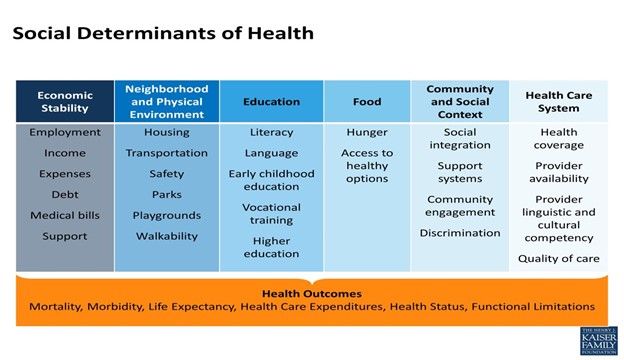2020 Census Deadline is September 30
 Residents must submit their response before the end of the day on Wednesday, September 30.
Residents must submit their response before the end of the day on Wednesday, September 30.
The Census occurs every 10 years when the U.S. government tallies people of all ages and backgrounds. The data will be used to help determine the allocation of billions of federal funds each year which help support education, housing, health programs and more. The Census also determines the number of seats each state will have in the U.S. House of Representatives.
To fill out the 2020 Census online, visit 2020census.gov.
Board of County Commissioners to Distribute $35 Million in CARES Funds to Support Health and Human Services, Small Business, and Workforce Needs

Today, the Johnson County Board of County Commissioners approved Phase II allocations totaling more than $35 million to address six focus areas with the Coronavirus Aid, Relief, and Economic Security Act (CARES) funding it received. The Phase II allocation process centered on community re-invested and supportive services in six focus areas including: Housing, Mental Health, Small Business, Workforce Development, Digital Access, and Aging.
During the first three weeks of September 2020, the County brought together approximately 80 Johnson County stakeholders and community members to determine how to allocate the federal funds intended to help Johnson County emerge stronger from the Coronavirus pandemic. The CARES Act was enacted on March 27 and appropriated $150 billion to states, counties and cities. Johnson County received a direct allocation from the federal government totaling $116,311,034. Additionally, the State of Kansas received nearly $1 billion and allocated $400 million to Kansas counties, including approximately $7 million to Johnson County. The current deadline for these funds to be spent is December 30, 2020.
UCS staff was honored to serve on the strike teams and oversight committee for this work.
After an intensive engagement process in which needs were identified, solutions were brainstormed and proposals were developed, a Community Reinvestment Committee (CRC) recommended 14 proposals for Board of County Commission (BOCC) consideration in the six focus areas. Click here to for the full report and details on the proposals.
2020 County Health Rankings and Health Equity
For the 5th year in a row, Johnson County is ranked as the healthiest county in Kansas, according to the 2020 County Health Rankings report released by the Robert Wood Johnson Foundation and the University of Wisconsin. The report reviews nearly 40 measures to determine how healthy our communities are now, and how our health may be impacted in the future. Some of these measures relate to health behaviors and clinical care while others are related to our physical environment and social and economic factors such as where we live, educational attainment opportunities, social connection, and community safety, otherwise known as social determinants of health.

Johnson County ranks 1st or 2nd among 104 counties in Kansas in several key areas of the ranking, including length and quality of life, health behaviors, clinical care, and social/economic factors. The exception is its ranking in physical environment. In 2020, the County ranked 72 out of 102 counties in physical environment. Health factors in the physical environment include measurements for housing, transportation, and pollution data.
The report does not disaggregate data by race, but the Census ACS 2018 5-year data indicates that Black people and other people of color are at higher risk for living in physical environments that contribute to poor health – even in the healthiest county in Kansas. For example, people of color are more likely to live in densely populated housing. They are also at risk for reduced quality of life due to lower household income. The per capita income for White residents is $47,609, compared to $29,774 for Black residents and $21,608 for Hispanic and Latino residents in Johnson County. Black Johnson County residents are three times more likely to live in poverty than White Johnson County residents; the Black poverty rate is 13.9% compared to 4.7% for the White population. The poverty rate for Hispanic and Latino residents is 15.9%. Clinical care is another factor that may create disproportionate health outcomes: White residents are uninsured at a rate approximate to that of the general population (5.4%) while the Black uninsured rate is more than double (12.1%). Hispanic and Latino residents are more than four times as likely to be uninsured (22.7%) than White residents.
Health factors are critical to understanding and mitigating health disparity, whereby a higher burden of illness, injury, disability, or mortality is experienced by one group relative to another. A complex and interrelated set of individual, provider, health system, societal, and environmental factors contribute to disparities in health. Notably in 2020, we observe health disparity in COVID-19 infection, according to Johnson County Department of Health and Environment. While people of color make up only 14% of the Johnson County population, Black and Hispanic residents are diagnosed with COVID-19 at a rate of up to three times higher than White residents.

Our community is only going to become more racially diverse over time. In the midst of calls from across our nation for systemic change, we must be thoughtful about planning now to ensure that current and future Johnson County residents of all races can achieve health and well-being through access to care, healthy choices, safe environments, and social and economic opportunity.
TAY Planning Project Speaker Series
UCS and the Transitional Age Youth Planning Project are presenting a three-part virtual workshop focusing on Best Practices to Effectively Partner with Youth. Each session will last for 90 minutes and will cover a different component. These dynamic training sessions will cover research-based best practices, outline tips for implementation, and promote transparent conversation to learn from one another. Anyone working with young people or anyone with a young person in their lives will benefit from this three-part series. The series launches September 24. There is still time to register for the second and third parts of the series. See below for information and links for registration:
Trauma-Informed Care: October 1, from 3:30pm – 5:00pm
- Trauma & Brain Development
- Strengths-based Approach
- Empowering Relationships (Include discussion around how Covid-19 restrictions and Black Lives Matter impact relationship building)
Harm Reduction: October 8, from 3:30pm – 5:00pm
- Power of Choice
- Acceptance versus Judgement
- Cycle of Behavior Change
- Wrap-up Activity where we apply all three approaches
Census Bureau Releases 1-year Estimates of Population, Poverty, and Other Demographics
The U.S. Census Bureau recently released 1year estimates from its 2019 American Community Survey. Data indicates that most indicators remained consistent with recent prior years. Notable statistics include:
- The population of Johnson County is 595,909 and the age group with the greatest population growth in the past 5 years is older adults age 65 and older (19% population growth since 2015).
- More than 80,000 Johnson County residents (13.6%) are “low-income”, living with incomes no more than twice the federal poverty level (FPL). This includes 31,774 Johnson County residents, or 5.3% of the population, living at or below the federal poverty level.
- The median household income in Johnson County is $91,771, a significant increase from past years ($86,746 in 2018). Houshold income is significantly lower than the county-wide median for Black households ($58,979), Hispanic households ($63,735), and female-headed households ($38,973)
- 36,107 residents age 0-64 are uninsured (compared to 38,543 in 2018)
Annual Census estimates provide useful guidance about how to coordinate health and human services, resources, and interventions. UCS will release a comprehensive fact sheet on the latest estimates in the next few weeks.


